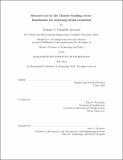Resource use in the Chinese building sector : foundations for analyzing urban transition
Author(s)
Accuardi, Zachary A. Campbell
DownloadFull printable version (3.154Mb)
Other Contributors
Massachusetts Institute of Technology. Technology and Policy Program.
Advisor
John E. Fernández.
Terms of use
Metadata
Show full item recordAbstract
Around the world, people are moving to cities in order to become wealthy, especially in developing countries undergoing socio-economic transition. This will dramatically change the way that society consumes resources, in terms of both materials and energy. We will need to better understand how resource use changes as development happens in order to focus efforts to reduce that resource use. China is undergoing this transition as it enters the global stage, and with global implications for resource use. The building sector in China is especially resource-intensive, fundamentally driven by the country's urbanization, and plays a prominent role in the Chinese economy, making it a good candidate for the study of how systems adopt sustainable practices. I approach this problem in two ways. The first is quantitative, using k-means statistical clustering on longitudinal resource use data from Chinese statistical yearbooks, in order to identify and compare transitions across provinces in China. In comparing the evolution of the building sector across provinces, my analysis suggests that development pathways are more distinct than discrete development stages. I identify two development pathway 'types' in China. The first is an urban path taken by Beijing, Shanghai, and Tianjin -- the three most heavily urbanized provinces. All other provinces follow a general business-as-usual path, though I also identify sub-pathways to further differentiate between the other 27 provinces. These development typologies are one means of quantitatively operationalizing the abstract notion of transition. Identifying such pathways may highlight opportunities for learning between provinces within the same path, and one could apply similar methods to other scales of analysis (e.g. urban or national). My second approach is qualitative, driven by interviews conducted primarily in Beijing with various stakeholders in the Chinese building sector. In this analysis, I discuss the particularities of the actors and processes involved in Chinese real estate development, identify opportunities for and barriers to reduced life-cycle energy use in buildings, and describe three distinctive and ongoing sustainability experiments with the potential for significant resource use reductions. This research emphasizes the need for integrated approaches to both research and practice in approaching sustainability transitions, and provides a set of complementary frameworks for their analysis.
Description
Thesis: S.M. in Technology and Policy, Massachusetts Institute of Technology, Engineering Systems Division, Technology and Policy Program, 2014. Cataloged from student-submitted PDF version of thesis. Includes bibliographical references (pages 149-162).
Date issued
2014Department
Massachusetts Institute of Technology. Engineering Systems Division; Technology and Policy ProgramPublisher
Massachusetts Institute of Technology
Keywords
Engineering Systems Division., Technology and Policy Program.